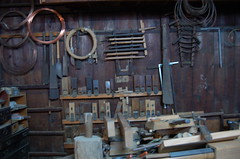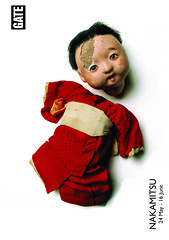The last bucket makers of Kyoto
We are called playwrights – like shipwrights – this naming suggests we playwrights are craftsmen. Practical before “artistic” although there is much art in a beautifully wrought ship.
Perhaps this is one reason why I have always felt an affinity for craftsmen and artisans.
In Japan, before machines, before plastic, buckets were made by hand.
These were small tub buckets for washing, large barrel buckets for making pickles, special well buckets for shrines and holy water, all forms of buckets.
No nails are used. Special tools place the pieces of wood to exact shape, so that they can slot together to produce a water tight bucket. Added strength is given by a bamboo or copper ring.
The wood is specially chosen, the right type of cedar or cypress is chosen, and all the elements are crafted by hand.
I was led to this craft by Diane Durston who wrote Old Kyoto, a guide to traditional shops and inns in Kyoto. Sadly the bucket maker that Diane knew had passed away a few years ago, and he had no family or apprentice to pass his craft down to. However I was determined to find a craftsman if I could.
After asking at the beautiful inn, Shiraume, where we were staying we found that there was a bucket maker left in Gion, Okesho.
Armed with a phrasebook, we found the shop. At first, I found out a little about what all the buckets were used for from the old lady who ran the ront of the shop but with my stilted Japanese, it was difficult. So she called out to her son (I presume) who appeared from the workshop.
I learned some of the Japanese names for the wood and we chose a small rice bucket and sushi tray to buy. My interest sparked an invite to look at his workshop and he showed us some of the process that goes into splitting, planning and joining the wood.

He makes his own tools – as is the way of most Japanese craftsmen – and the craft is hundreds of years old. I asked him how many hand made bucket shops were left. He thought perhaps two or three.
And how many people who still knew how to make buckets? Only five.
Only five people left who know this craft. In one more generation, the craft will probably be lost and there will be no more hand made buckets.
comments
2 Responses to “The last bucket makers of Kyoto”


Very interesting! I’m interested in bucket makers who might still make well buckets for ikebana. The Well Bucket Arrangement is very traditional and famous. Difficult to find information on this. Can you tell me where I can find these bucket makers in Japan?
I am organizing a craft tour in Kyoto and the surrounding area for 2008. I also have a particular interest in finding a cooper’s shop. This is a craft that I apprenticed in 1972.
Can you provide me with any names, addresses or phone numbers? I have a Japanese friend who can do any required translating.